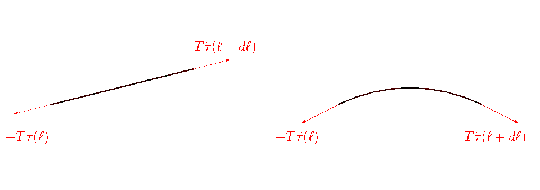First of all,
$\frac{\partial^2 y}{\partial x^2}$ and $\frac{\partial^2 y}{\partial t^2}$ are second partial derivatives of $y(x,t)$ with respect to $x$ and $t$. So you can't obtain the wave equation from the first order equation
$$v \frac{\partial y}{\partial x} = \frac{\partial y}{\partial t}$$
by squaring it in an algebraic sense. Also the square of the differential operator
\begin{equation}
v \frac{\partial}{\partial x}-\frac{\partial}{\partial t}
\end{equation}
is not the correct one. I will comment about that at the end.
About the intuitive explanation: a piece of the string is subject to a force (and, as a consequence, to an acceleration $\partial^2 y/\partial t^2$) which is proportional to its curvature, which is measured for small slopes by the second derivative $\partial^2 y/\partial x^2$. The reason for this is that at the edges of the string the tension gives tangent forces (see the figure)

In the first approximation you neglect the second derivative, and the piece of string is approximated by a segment. In this case there is no net force, because the effects of the tension at the two edges cancel (figure on the left). In a second approximation the piece of string is curved (figure on the right) and you get a net transverse force.
Note that you can write the wave equation in the form
$$\left(\frac{\partial}{\partial x}-\frac{1}{v} \frac{\partial}{\partial t} \right)\left(\frac{\partial}{\partial x}+\frac{1}{v} \frac{\partial}{\partial t} \right)y(x,t)=0$$
by factorizing the differential operator. You see that $y(x,t)$ is a solution of the wave equation if it is a solution of
$$\left(\frac{\partial}{\partial x}-\frac{1}{v} \frac{\partial}{\partial t} \right)y(x,t)=0$$
or if it is a solution ofs
$$\left(\frac{\partial}{\partial x}+\frac{1}{v} \frac{\partial}{\partial t} \right)y(x,t)=0$$
In the first case the most general solution is $y(x,t)=F(x+vt)$, in the second $y(x,t)=G(x-vt)$, where $F$ and $G$ are arbitrary functions. The first equation is equivalent to the one you are trying to derive the wave equation from: it describes an arbitrary wave which moves in the left direction. But there are also waves which moves in the right direction, which are solution of the second equation. The correct wave equation contains the product of both the first order differential operators, and not the square of one of them.
